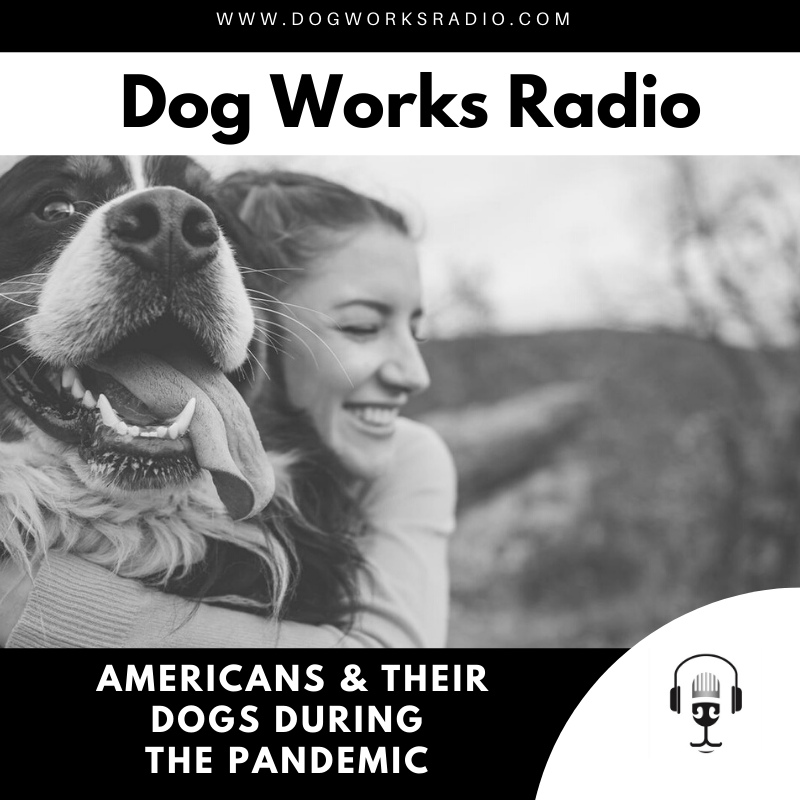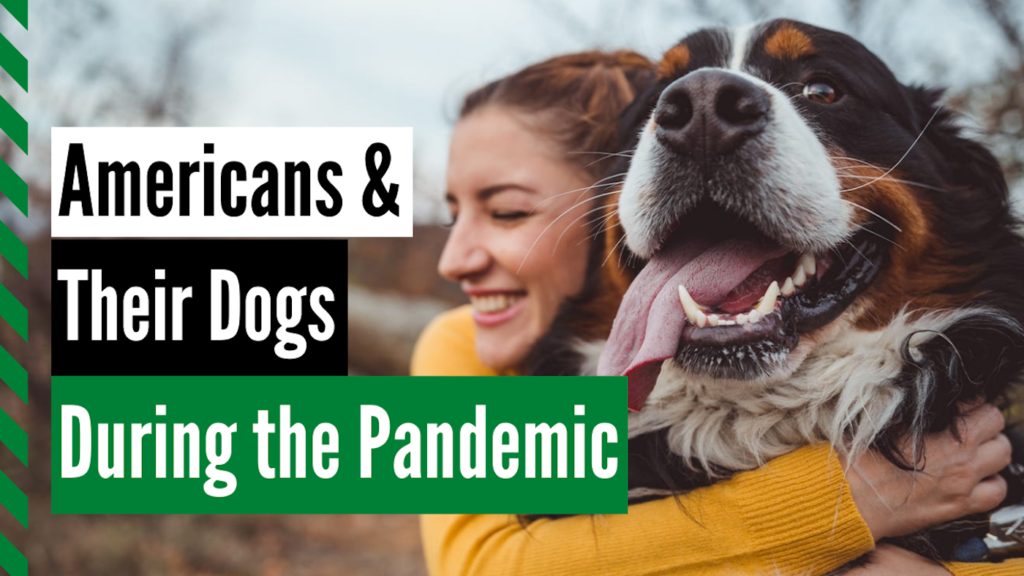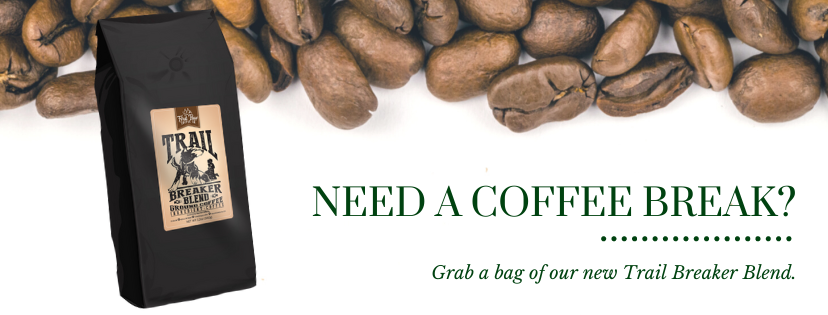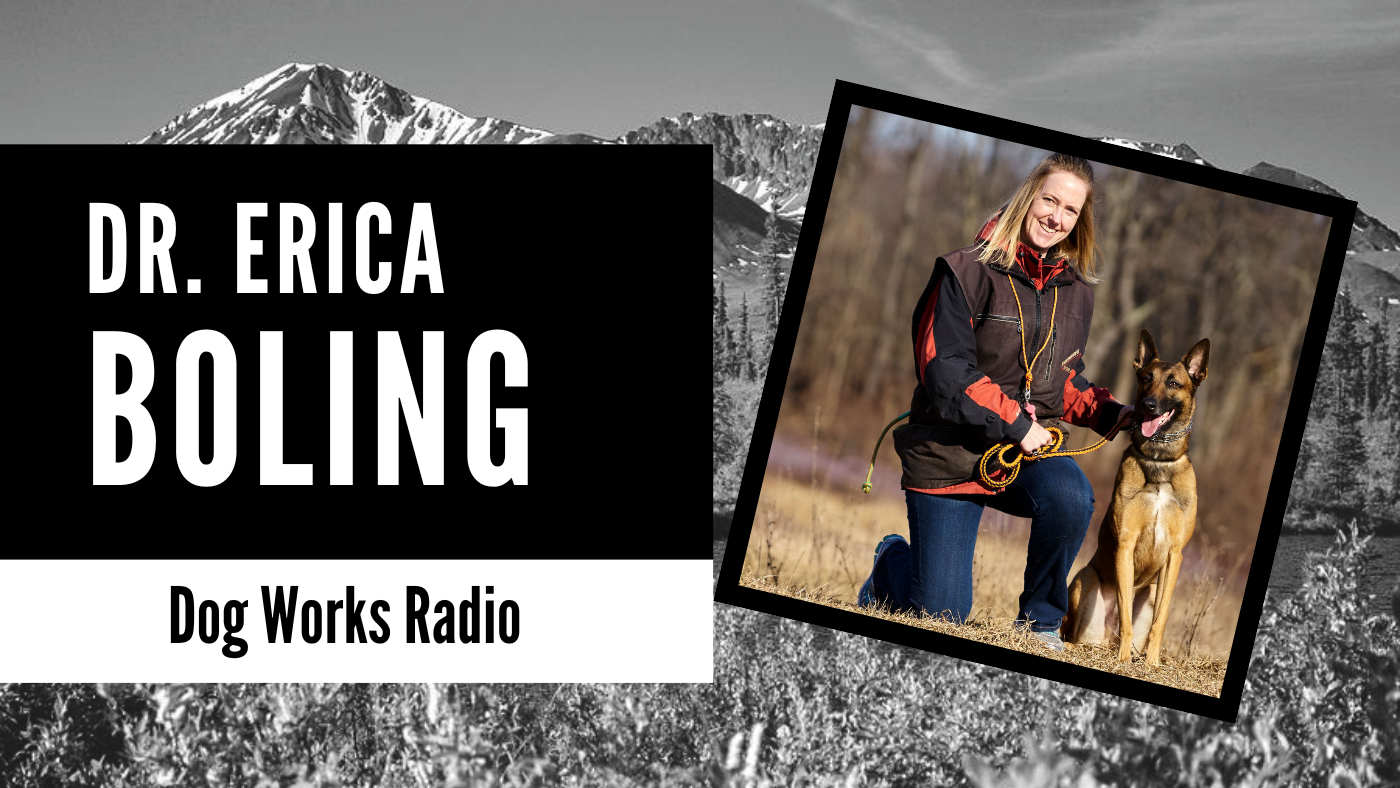Join host Michele Forto as she presents Americans and their Pets during the Pandemic?
A year into the COVID-19 crisis, it’s clear the pandemic has affected relationships in all facets of Americans’ lives — including those with the animals they love. On today’s show, we are going to take a deep dive into a study that tries to answer some of the questions about how we take care of our pets during the pandemic. Even though this episode is a bit stat-heavy, it is a great look into our lives with pets.
What we talk about on this episode:
- The more urbanized the pet owner, the more likely they were to say their pet outlook had positively changed in the past year.
- Three-quarters of owners said they take their pet to the vet at least annually for checkups, vaccinations, and other routine care.
- A Mushing Radio update
- Our Calendar of Events
Hello and welcome to Dog Works Radio. I am Michele Forto and I am the lead trainer of Alaska dog works. Here we help owners and their dogs have a better relationship. On today’s show, we are talking about a study that looked at Americans and their Pets during the Pandemic. A wide-ranging national poll of more than 1,300 pet owners conducted in early March by Money and Morning Consult explored not only changes to how owners interacted with their pets during the pandemic but what they spent on them — as well as what they might be willing to spend on medical bills, were the worst to happen to their animal.
The study also looked at how and why Americans acquired new non-human companions during the past 12 months. Other questions covered pet-owners’ confidence in the vets entrusted with their medical care, and owners’ knowledge of pet insurance.
The results revealed a deepened relationship during the pandemic between humans and their pets, reflected in part through a willingness to spend almost anything to provide for their animals’ care. We also found that what Americans expect from pet insurance and what it usually delivers may often be at odds.
Even today, with lockdowns lifting and vaccinations expanding, Americans continue to spend an average of at least 20% more time during the day at home than before the pandemic, according to Google’s Community Mobility Data.
Holing up at home inevitably means more time with pets than was the case in the era of commuting, live events, eating out, and more. Fortunately, the trend has been mostly a positive development, the survey found. More than half of respondents said they value their pets more (58%) and are more affectionate (50%) to them now than they were in pre-COVID-19 times. And at least some of those (31% and 37%, respectively) who reported no change in those measures may feel that way because they think in absolute terms: they couldn’t value or love their pet any more than they did before the pandemic.
Dog and cat owners reported almost identical increases in the value and affection they lavished on their animal, as did owners of purebred and mixed-breed pets.
Interestingly, the more urbanized the pet owner, the more likely they were to say their pet outlook had positively changed in the past year. Suburbanites had middling increases in their feelings for their pet, but those with a rural home were notably less inclined than owners as a whole to report step-ups in the value (53% vs. 58%) or affection (41% vs. 50%) they feel for their pets now. Urbanites, on the other hand, went in the opposite direction from the norm — averaging 61% on increased value and 64% on being more affectionate.
The negatives to pandemic pet-ownership were fairly minor. A minority (11%) did report their pet annoys them more now.
A slightly higher, but still small (16%), the proportion of owners reported trouble in keeping up with their pets’ needs. But increased dog walking doesn’t appear to be the issue here. Roughly one in five dog owners said they got help during the day before the pandemic with walking and other pet care. But only one in five of that group — who presumably would feel a burden now, having lost their assistance — said care for their pooch was more work now than when they had help.
It could be, that people like walks with their dog, so doing it more doesn’t seem like work. But a perhaps-surprising data point may also come into play: Only half of dog owners now report taking more walks with their dog now than before March 2020.
We did find a relationship between age and difficulty keeping up with pets’ needs. The youngest pet owners — those 18 to 34 years old — were far more likely to agree that they struggled with pet care (21%) than seniors (8%).
Dogs and cats aren’t being showered with expensive new snacks or playthings in the COVID-19 era, based on the data. Pet owners’ spending has remained steady from before the pandemic, other than slight increases among the heaviest spenders — those who rack up more than $150 a month on food, toys, and other non-medical expenses. More than two-thirds (71%) of owners said they spent $100 or less a month on their pet now and spent the same amount before March 2020.
More than one in five respondents to the survey (22%) said they’d welcomed a new animal into their lives since March 2020. The age of the owner (and others in the home) made a big difference in the likelihood of becoming a new pet parent.
Younger people and younger families were by far the most likely to have added a pandemic pet. GenZers (born 1997-2012), Millennials (born 1981-1996), and families with kids at home were all about 50% more likely than respondents as a whole to have acquired an animal since March 2020.
For many, it seems, the pandemic provided the excuse they’ve always wanted to get animal companionship since a long-time desire to get a pet topped the motivations to take the pet plunge now (with 72% citing it). But more time, especially at home, was also frequently cited. As was plain loneliness, which more than half of respondents (52%) said was among their motivators.
Shelters by far dominated the places where the new pet was acquired (at 37%). That’s unsurprising, perhaps, given the sustained surge in interest in so-called rescue pets during the pandemic. Buying from a breeder came next (20%), followed closely by being gifted a pet (17%) and buying it from a pet store (16%).
Since shelters were the most popular places to get a pet, they asked Yelp, the crowdsourced ratings service, to identify the place in every state that its raters had scored highest for adopting a pet.
Interest in new pets has surged in the past year. According to Google data, the search terms “rescue dogs “and “shelter dogs” hit all-time traffic highs a few weeks into the pandemic and have stayed above their five-year averages ever since.
Given that crush, we might have expected significant dissatisfaction with the pet-buying process, as sellers struggle with a crush of new buyers. Instead, overall satisfaction with the pet purchasing experience was almost as high as it could be (95%), and there was virtually no difference in satisfaction between the different ways to acquire a pet: from a shelter, breeders, or pet store. People who purchased from a pet store, though, were less likely to say they are very satisfied (69%) than those who bought in other ways.
In response to the findings, Brandi Hunter, Vice President of Public Relations & Communications at the American Kennel Club, said the organization was “happy to see that a vast majority of those who chose to get a dog from a breeder were satisfied. We advocate for all people to acquire a dog in a responsible, well-researched manner, as adding a pet to the home is a big commitment.”
During the purchase experience, few buyers faced hidden or unexpected charges (6% overall, across all sources), though 15% of pure-breed cat buyers did, along with 10% of those who purchased from a pet store.
Interestingly, almost as many buyers reported the need for references and/or background checks from breeders (16%) and pet stores (19%) as with shelters (20%).
Pets are more than companions; they’re also potential patients who receive both routine and occasional acute medical care.
Three-quarters of owners said they take their pet to the vet at least annually for checkups, vaccinations, and other routine care — as the American Animal Hospital Association recommends. Purebred pets and those owned by people who reported good to excellent finances were more frequent visitors to the vet. For example, nine of every ten respondents with annual incomes of $100,000 or more went to the vet at least annually for routine reasons. Close to half of those wealthier owners (44%) visited more than once a year, which is far higher than the 25% of owners overall who did so. Conversely, only about two-thirds of those who said their financial situation was poor to fair reported making annual visits to the vet.
Owners reported going to the vet for acute care far less often (34% at least once a year). Owners with $100,000 + incomes or who owned purebred pets were again more likely than most to make visits. That data could reflect the propensity of some purebreds to hereditary trouble or a greater inclination by wealthier owners to take their pet in for even minor problems — or neither of those things.
Respondents showed a willingness to spend big to preserve their pets’ lives, while also showing some realism about those end-of-life decisions. More than two-thirds say they would take any measure to save their pet’s life, regardless of cost (67% agree), and even more (80%) said they’d take any measure they could afford. Responses to these questions changed predictably based on the financial situation, but the effects of affluence were less than for responses to most other vet care inquiries.
Other responses, though, suggested pet owners may be more hard-headed than that data suggests. Six in ten pet owners said they’d weigh the cost of treating their pet against their finances, and nearly as many (54%) said they’d seriously consider the cost of treatments if their pet was older. And about half that proportion (28%) said they wouldn’t take expensive measures to save their pet, regardless of its age.
There were modest age differences in these responses, with young people generally showing more willingness to take any needed medical measures. But the only effect of affluence, interestingly, was that those who reported a poor to fair financial situation were a little more likely to say they’d spend as needed to save their pet than were wealthier respondents.
It’s clear, though, that pet owners put a lot of weight in what the vet recommends in regards to care for their pet, including those when the animal is old. At least two-thirds agreed that they trusted their animal doctor not to over-treat their pet and that they’d pay for the treatment the vet recommends, regardless of the pet’s age.
The survey provides mild support for reports that vet appointments are a little harder to get than they were pre-pandemic, perhaps due to an influx of new puppies and kittens who need shots and the like. Nearly half of pet owners (44%) affirmed informal reports that it has become harder to snag a vet appointment than before the pandemic. Young pet owners were more likely to report that, perhaps because their schedules were less flexible than older workers or retirees.
Some of those who use a pet training service also reported greater difficulty in getting onto the schedules of those professionals, although to a lesser extent (29% agreement).
Pet insurance — which is health coverage for the animals in the lives — has been among the fastest-growing pet products in recent years. Sales in dollars have been growing annually by double-digit percentages, according to the North American Pet Health Insurance Association.
Still, only one in five (20%) survey respondents had insurance on their pets or had it previously. But word on this coverage has apparently spread more widely, and nearly three times as many pet owners we surveyed (56%) reported some familiarity with pet insurance — although most of those (39%) said they were somewhat rather than very (17%) familiar with the product.
The relatively weak familiarity may explain why, when asked about what pet insurance covers, significant majorities indicated they’d expect reimbursement for expenses that they would not — or very likely would not — receive under most or all policies.
The relatively weak familiarity may explain why, when asked about what pet insurance covers, significant majorities indicated they’d expect reimbursement for expenses that they very likely would not receive under most policies.
True, more than three in five respondents (76%) accurately grasped the main benefit of most pet insurance — that it reimburses at least part of major expenses above $500 in any one year. And fewer than a quarter of respondents (24%) incorrectly believed they’d be reimbursed for treatment of conditions the pet already had when it was first insured.
Still, many (43%) respondents believed routine visits, such as for vaccinations, would be covered by a policy. That is statistically very unlikely, given that most policies sold cover only accidents and illness treatment, and generally omit routine care.
Almost the same proportion of owners (39%) believed they would get reimbursement for vet visits up to $500 a year when there’s almost invariably an annual deductible on policies (of at least $200), and no payments are made until that is met.
Further, more than a third of respondents (38%) expected they’d be spared paying for vet costs upfront, as with many human health policies. But that’s a rare perk with pet insurance, which almost always requires payment in advance, after which the pet owner applies for reimbursement from the insurer.
Owners who currently had insurance, or had it previously, showed better knowledge of likely coverage. Still, the only sizable edge (10%) among policyholders, past or present, was in more accurately understanding the upfront-payment provision.
I know that was a lot of info but my goodness, what an enlightening study. What do you think? Let us know in the comment section of where you are listening to the show.
We are going to quickly turn it over to Robert to give us his Mushing Radio update.
Kobuk 440, spring mushing, chores in the dog yard. Iditarod coverage stats and thank you. Upcoming Rock on Racing series, interview with Jake Hway about retired sled dogs
It is now time our calendar of events. For those that are listening locally on KVRF or our current and past clients stay tuned for important announcements, for our other listeners, stick around and you might learn something cool.
As you may have heard March is Poison Prevention Awareness Month.
March 30: Take a Walk in the Park Day. Although not exclusively a pet holiday, this day makes a great time to explore a new park with your dog!
Coming up in April there is a lot going on:
Month-Long Observances
- Canine Fitness Month.
- Active Dog Month. This is a great time to check out our Adventure Dogs Club. You can find out more on our website at Alaska dog works.com
- National Adopt a Greyhound Month.
- National Heartworm Awareness Month.
- National Pet First Aid Awareness Month. This event is an effort by the American Red Cross to draw attention to the need-to-know specialized pet first aid. Did you know that is also one of our merit badges in the Adventure Dog Club too?
- Prevent Lyme Disease in Dogs Month.
- Prevention of Cruelty to Animals Month. (ASPCA)
- National Pet Month.(in the UK)
In early April we will be at the Mat Su Outdoorsman show at the Alaska State Fairgrounds in Palmer for this three-day event. Come out and say hello. We like it when you say hi. We will also have all of our coffee blends on sale, a bunch of gear and you can learn all about our adventure dog club just in time for spring. We are excited about this one. It was canceled last year because of COVID but this year is supposed to be bigger than ever. Not only will we be there but there will be food trucks, live events, demonstrations, and much more. This is the premier event for anyone that is interested in getting outdoors in Alaska.
On April 17 we will be starting our group classes in the park. They will be held at Wonderland Park in Wasilla at 11:30 am. These are free for our current and past clients and are part of your training package. If you are not a client or just want to check us out, this is a great way. We do have a nominal drop-in fee.
We are gathering gear for our first ever nose work class and treiball and Robert is going to do pack walks again too. If you want to get an idea of what we will be doing, head on over and watch the Pack on Amazon Prime Video. It is a really cool show!
Did you know that every Wednesday and Sunday night we do a Facebook Live at 7 pm? Be sure to check us out. If you miss the live broadcasts, you can always tune in later too.
Also, stay tuned for info about the Summer Festival, how you can train your dog to run in the Alaska Dog Works Dryland Derby this fall, and much more. As always you can keep up to date by following us on our social channels, just search Dog Works Radio and for more training tips and tricks and to learn how to schedule a free discovery call to talk with us about how to make your dog one of the best, visit Alaska dog works.com
See you next time
Host, Michele Forto’s Bio: Michele Forto is the lead trainer for Alaska Dog Works where they train dogs for service work, obedience, and more. Michele is also the business manager and husky wrangler for Team Ineka. When Michele is not training dogs she loves to travel on their annual Rock n Roller Tours where she and Robert hit up rock concerts and roller coasters around the country.
Host, Robert Forto’s Bio: Robert Forto is the training director for Alaska Dog Works where they train dogs for canine obedience, working dogs, therapy dogs, and service dogs for clients all over North America. He is also a dog musher and he and his wife operate a 36-dog mushing kennel in Willow, Alaska, called Team Ineka. They can often be seen at local races and leading expeditions in the Alaska backcountry with outdoor leadership students at the University of Alaska. Robert is the producer of Dog Works Radio that has been on the air since 2009 and is currently simulcast on a local radio station, KVRF in Palmer, Alaska.
Links and Resources Mentioned:
- RSS feed for our show: https://dogworksradio.libsyn.com/rss
- Alaska Dog Works
- First Paw Coffee
- Robert Forto on Twitter: @robertforto
- Dog Works Radio on Twitter: @dogworksradio
- Michele Forto on Twitter: @micheleforto
- Alex Stein on Twitter: @coldfootfilms
- Dog Works Radio on Facebook
- Dog Works Radio on Instagram
- KVRF in Alaska
Thanks for Listening! We appreciate your visiting our site today and for help in bringing awareness to the Dog Works Radio podcast
Where we are going? (In real life)
- Rock n Roller Coaster Tour 21 #rocknroller21 to live host The Coaster Geeks Podcast
- Podcast Movement 21 in Nashville in August #PM21
Audience feedback drives the show. We would love for you to email us and keep the conversation going! Email live@dogworksradio.com or call us at 907-841-1686
-
- We would love to hear from you!
Help us spread the word! We would love it if you could please share #DogPod with your Twitter followers. Click here to post a tweet If you dig this episode head over to Apple Podcasts and kindly leave us a rating or a review and subscribe!
Ways to subscribe to Dog Works Radio
Feedback and Promotion You can ask your questions, make comments, and request a show topic! Let your voice be heard.
-
- Email live@dogworksradio.com
- Book an interview on the show
- Take the Survey



















